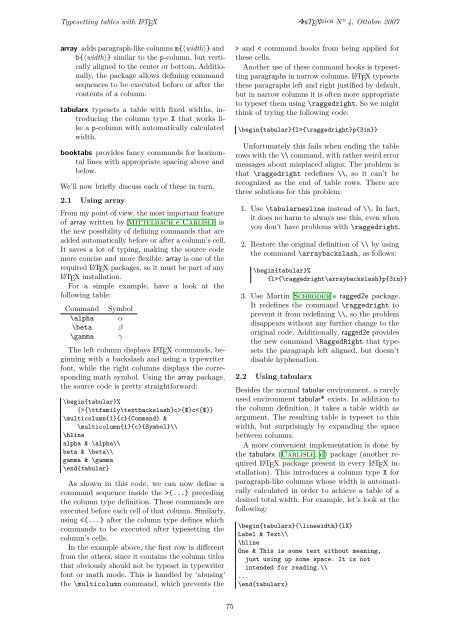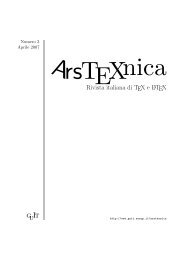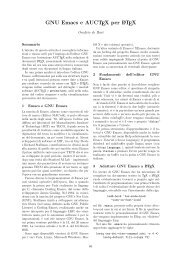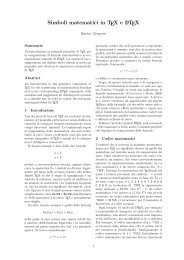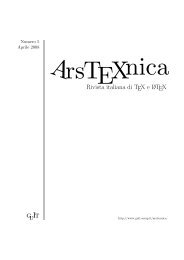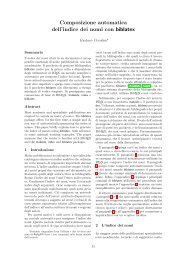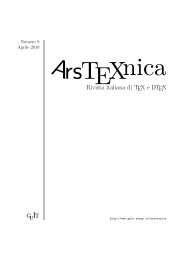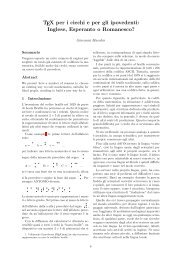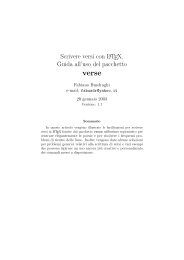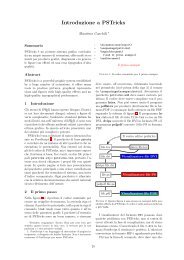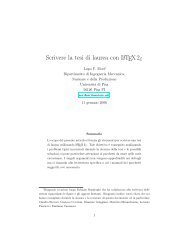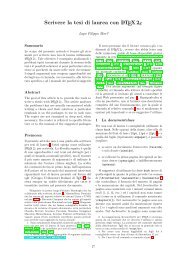ArsTeXnica, Numero 4, Ottobre 2007 - GuIT - Scuola Superiore Sant ...
ArsTeXnica, Numero 4, Ottobre 2007 - GuIT - Scuola Superiore Sant ...
ArsTeXnica, Numero 4, Ottobre 2007 - GuIT - Scuola Superiore Sant ...
Create successful ePaper yourself
Turn your PDF publications into a flip-book with our unique Google optimized e-Paper software.
Typesetting tables with L ATEX ArsTEXnica Nº 4, <strong>Ottobre</strong> <strong>2007</strong><br />
array adds paragraph-like columns m{〈width〉} and<br />
b{〈width〉} similar to the p-column, but vertically<br />
aligned to the center or bottom. Additionally,<br />
the package allows defining command<br />
sequences to be executed before or after the<br />
contents of a column.<br />
tabularx typesets a table with fixed widths, introducing<br />
the column type X that works like<br />
a p-column with automatically calculated<br />
width.<br />
booktabs provides fancy commands for horizontal<br />
lines with appropriate spacing above and<br />
below.<br />
We’ll now briefly discuss each of these in turn.<br />
2.1 Using array<br />
From my point of view, the most important feature<br />
of array written by Mittelbach e Carlisle is<br />
the new possibility of defining commands that are<br />
added automatically before or after a column’s cell.<br />
It saves a lot of typing, making the source code<br />
more concise and more flexible. array is one of the<br />
required L ATEX packages, so it must be part of any<br />
L ATEX installation.<br />
For a simple example, have a look at the<br />
following table:<br />
Command Symbol<br />
\alpha α<br />
\beta β<br />
\gamma γ<br />
The left column displays L ATEX commands, beginning<br />
with a backslash and using a typewriter<br />
font, while the right columns displays the corresponding<br />
math symbol. Using the array package,<br />
the source code is pretty straightforward:<br />
\begin{tabular}%<br />
{>{\ttfamily\textbackslash}c>{$}c{...} preceding<br />
the column type definition. These commands are<br />
executed before each cell of that column. Similarly,<br />
using and < command hooks from being applied for<br />
these cells.<br />
Another use of these command hooks is typesetting<br />
paragraphs in narrow columns. L ATEX typesets<br />
these paragraphs left and right justified by default,<br />
but in narrow columns it is often more appropriate<br />
to typeset them using \raggedright. So we might<br />
think of trying the following code:<br />
\begin{tabular}{l>{\raggedright}p{3in}}<br />
Unfortunately this fails when ending the table<br />
rows with the \\ command, with rather weird error<br />
messages about misplaced aligns. The problem is<br />
that \raggedright redefines \\, so it can’t be<br />
recognized as the end of table rows. There are<br />
three solutions for this problem:<br />
1. Use \tabularnewline instead of \\. In fact,<br />
it does no harm to always use this, even when<br />
you don’t have problems with \raggedright.<br />
2. Restore the original definition of \\ by using<br />
the command \arraybackslash, as follows:<br />
\begin{tabular}%<br />
{l>{\raggedright\arraybackslash}p{3in}}<br />
3. Use Martin Schröder’s ragged2e package.<br />
It redefines the command \raggedright to<br />
prevent it from redefining \\, so the problem<br />
disappears without any further change to the<br />
original code. Additionally, ragged2e provides<br />
the new command \RaggedRight that typesets<br />
the paragraph left aligned, but doesn’t<br />
disable hyphenation.<br />
2.2 Using tabularx<br />
Besides the normal tabular environment, a rarely<br />
used environment tabular* exists. In addition to<br />
the column definition, it takes a table width as<br />
argument. The resulting table is typeset to this<br />
width, but surprisingly by expanding the space<br />
between columns.<br />
A more convenient implementation is done by<br />
the tabularx (Carlisle, d) package (another required<br />
L ATEX package present in every L ATEX installation).<br />
This introduces a column type X for<br />
paragraph-like columns whose width is automatically<br />
calculated in order to achieve a table of a<br />
desired total width. For example, let’s look at the<br />
following:<br />
\begin{tabularx}{\linewidth}{lX}<br />
Label & Text\\<br />
\hline<br />
One & This is some text without meaning,<br />
just using up some space. It is not<br />
intended for reading.\\<br />
...<br />
\end{tabularx}


